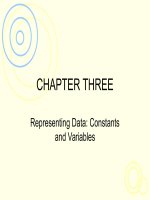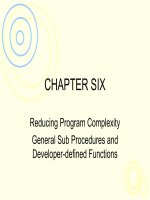Lecture Using information technology (11/e): Chapter 7 - Brian K. Williams, Stacey C. Sawyer
Bạn đang xem bản rút gọn của tài liệu. Xem và tải ngay bản đầy đủ của tài liệu tại đây (1.32 MB, 43 trang )
Using Information Technology, 11e
Personal Technology:
The Future Is You
7
Chapter
©
© 2015
2015 by
by McGraw-Hill
McGraw-Hill Education.
Education. This
This proprietary
proprietary material
material solely
solely for
for authorized
authorized instructor
instructor use.
use. Not
Not authorized
authorized for
for sale
sale or
or distribution
distribution in
in any
any manner.
manner. This
This document
document may
may not
not be
be copied,
copied, scanned,
scanned, duplicated,
duplicated, forwarded,
forwarded, distributed,
distributed, or
or posted
posted on
on a
a website,
website, in
in whole
whole
or
or part.
part.
Chapter Topics
Using Information Technology, 11e
UNIT 7A:Personal Devices for Improving Productivity at School &
Work
7.1
Convergence, Portability, & Personalization
7.2
Smartphones: More Than Talk
7.3 Tablets & E-Readers
7.4
Portable Media Players
UNIT 7B: personal Devices for Enriching Leisure & Life
7.5
7.6
Digital Cameras: Changing Photography
High-Tech Radio: Satellite, Hybrid Digital, & Internet
2
© 2015 by McGraw-Hill Education. This proprietary material solely for authorized instructor use. Not authorized for sale or distribution in any manner. This document may not be copied, scanned, duplicated, forwarded, distributed, or posted on a website, in whole
or part.
Using Information Technology, 11e
UNIT 7A: Personal Devices for Improving Productivity
at School & Work
• The ongoing shift toward a more interactive and
participatory web is exemplified by the mashup, a
creative combination of content or elements from
different sources, such as a web page that blends data
from two or more sources to create new services or
content.
3
© 2015 by McGraw-Hill Education. This proprietary material solely for authorized instructor use. Not authorized for sale or distribution in any manner. This document may not be copied, scanned, duplicated, forwarded, distributed, or posted on a website, in whole
or part.
Using Information Technology, 11e
7.1 Convergence, Portability,
& Personalization
4
© 2015 by McGraw-Hill Education. This proprietary material solely for authorized instructor use. Not authorized for sale or distribution in any manner. This document may not be copied, scanned, duplicated, forwarded, distributed, or posted on a website, in whole
or part.
Three major trends in information technology continue to be
Using Information Technology, 11e
convergence, portability, and personalization.
Convergence: Combining of several industries – computers,
communications, consumer electronics, entertainment, and
mass media – through various devices that exchange data in
digital form
• Pros:
• Increased convenience of devices; more affordable; more functions
• Cons:
5
© 2015 by McGraw-Hill Education. This proprietary material solely for authorized instructor use. Not authorized for sale or distribution in any manner. This document may not be copied, scanned, duplicated, forwarded, distributed, or posted on a website, in whole
or part.
Portability
Using Information Technology, 11e
• Pros
• Devices that enable phone, texting, and email access from anywhere,
portable digital music, GPS, and convenient cheap digital photos that allow
people to remain connected even while on the move
• Cons
• Bombardment by texts and phone calls; intrusiveness; time wasters
• Lack of face-to-face contact can lead to misinterpretations
6
© 2015 by McGraw-Hill Education. This proprietary material solely for authorized instructor use. Not authorized for sale or distribution in any manner. This document may not be copied, scanned, duplicated, forwarded, distributed, or posted on a website, in whole
or part.
Personalization
Using Information Technology, 11e
• Pros
• People can do many things, customized just for them. Downloaded hundreds
or thousands of songs, so that they have their own personalized library of
music; create lists of “favorites” or “bookmarks” so that they can readily
access favorite website; access or contribute to blogs or personalized online
diaries. In addition, PC software can be used to create all kinds of personal
projects, ranging from artwork to finances to genealogy.
• Get preselected news topics delivered to one’s electronic devices as needed.
7
© 2015 by McGraw-Hill Education. This proprietary material solely for authorized instructor use. Not authorized for sale or distribution in any manner. This document may not be copied, scanned, duplicated, forwarded, distributed, or posted on a website, in whole
or part.
• Personalization (continued)
Using Information Technology, 11e
• Cons
• Having many personalized devices leads to multitasking, which can lead to
“absent presence” and nonfocus
• Regret about choices
• Inaction
• Excessive expectations
• Self-blame
• “Paralysis” from too many choices
• Filtering
8
© 2015 by McGraw-Hill Education. This proprietary material solely for authorized instructor use. Not authorized for sale or distribution in any manner. This document may not be copied, scanned, duplicated, forwarded, distributed, or posted on a website, in whole
or part.
Using Information Technology, 11e
7.2 Smartphones
• More Than Talk
9
© 2015 by McGraw-Hill Education. This proprietary material solely for authorized instructor use. Not authorized for sale or distribution in any manner. This document may not be copied, scanned, duplicated, forwarded, distributed, or posted on a website, in whole
or part.
Using Information Technology, 11e
Smartphone = cellphone with microprocessor, memory,
display screen, modem, apps, and Internet access
• Allows phone calls, email, web browsing, music availability, text
messaging, videogames, digital TV viewing, search tools, GPS,
personal information management, and so on
• Storage
• Data is stored in flash memory card
• Data does not disappear when phone is turned off
10
© 2015 by McGraw-Hill Education. This proprietary material solely for authorized instructor use. Not authorized for sale or distribution in any manner. This document may not be copied, scanned, duplicated, forwarded, distributed, or posted on a website, in whole
or part.
Using Information Technology, 11e
CELLPHONES: DESIGNED FOR
CALLS & PERHAPS TEXTING
• Lower-priced than smartphones,
© 2015 by McGraw-Hill Education. This proprietary material solely for authorized instructor use. Not authorized for sale or distribution in any manner. This document may not be copied, scanned, duplicated, forwarded, distributed, or posted on a website, in whole
or part.
• Cellphones are radios
Using Information Technology, 11e
• OS is stored in ROM; apps are downloaded
• Display screens are 2 – 5 inches, color
• Storage usually on flash memory cards
• Have tactile or touch-screen keyboards
• Microphone for voice commands
• Receiver/Speaker to hear voice calls
• Have headset connector
• Are MP3/media players
• Use Wi-Fi and/or Bluetooth
12
© 2015 by McGraw-Hill Education. This proprietary material solely for authorized instructor use. Not authorized for sale or distribution in any manner. This document may not be copied, scanned, duplicated, forwarded, distributed, or posted on a website, in whole
or part.
Using Information Technology, 11e
• Text messaging, or texting or SMS (for short message
service), is the sending of short messages, generally no
more than 160 characters in length (including spaces), to a
smartphone or other handheld device.
13
© 2015 by McGraw-Hill Education. This proprietary material solely for authorized instructor use. Not authorized for sale or distribution in any manner. This document may not be copied, scanned, duplicated, forwarded, distributed, or posted on a website, in whole
or part.
• Societal Effects of Cellphones
Using Information Technology, 11e
• Positive (among others)
• Parents can more easily monitor their children
• Police dispatchers can help people who are lost
• Information and amusements are readily available
• Get road assistance
• Information can get out quickly during emergencies
• Negative (among others)
• People are less polite, courteous, and respectful using cellphones
• Cellphones are answered in theaters and restaurants
14
© 2015 by McGraw-Hill Education. This proprietary material solely for authorized instructor use. Not authorized for sale or distribution in any manner. This document may not be copied, scanned, duplicated, forwarded, distributed, or posted on a website, in whole
or part.
Using Information Technology, 11e
7.3 Tablets & E-Readers
15
© 2015 by McGraw-Hill Education. This proprietary material solely for authorized instructor use. Not authorized for sale or distribution in any manner. This document may not be copied, scanned, duplicated, forwarded, distributed, or posted on a website, in whole
or part.
Using Information Technology, 11e
A tablet is a general-purpose computer contained in a single
panel; it is a combination of smartphone and laptop computer
with wireless connections, a 7- to 12-inch multitouch screen,
and a virtual screen.
•
Platforms (OS): iPad, Android, Windows RT
16
© 2015 by McGraw-Hill Education. This proprietary material solely for authorized instructor use. Not authorized for sale or distribution in any manner. This document may not be copied, scanned, duplicated, forwarded, distributed, or posted on a website, in whole
or part.
Using Information Technology, 11e
E-readers are better than tablets for reading ebooks in terms of price, screen quality, simplicity
and portability.
• E-Book, or electronic book: electronic text, the
digital-media equivalent of a conventional printed
book
• E-Book Reader: electronic device that can download
books (wired and wirelessly)
• Examples: Kindle (Amazon); Nook (Barnes & Noble)
17
© 2015 by McGraw-Hill Education. This proprietary material solely for authorized instructor use. Not authorized for sale or distribution in any manner. This document may not be copied, scanned, duplicated, forwarded, distributed, or posted on a website, in whole
or part.
• Some Benefits of E-Readers
Using Information Technology, 11e
• One e-book reader can store hundreds or thousands of books.
• Easy to download books by wireless access; books are less
expensive.
• Type size and face can be adjusted.
• Usually can be read in low light.
• Automatically opens to the page where you left off.
• Text can be searched and cross-referenced.
• Dictionary automatically available.
18
© 2015 by McGraw-Hill Education. This proprietary material solely for authorized instructor use. Not authorized for sale or distribution in any manner. This document may not be copied, scanned, duplicated, forwarded, distributed, or posted on a website, in whole
or part.
Using Information Technology, 11e
How an E-Reader Works
• E-readers use E Ink, which is composed of millions of tiny
particles that display text.
• Different e-books use different e-software formats.
• E-books are downloaded by wireless access (3G or Wi-Fi).
© 2015 by McGraw-Hill Education. This proprietary material solely for authorized instructor use. Not authorized for sale or distribution in any manner. This document may not be copied, scanned, duplicated, forwarded, distributed, or posted on a website, in whole
or part.
Some drawbacks of e-readers:
Using Information Technology, 11e
• Photos, charts, diagrams, foreign characters, and tables not as
good as in print version—or are left out of the e-book
• Battery needs to be recharged
• Reader doesn’t own the downloaded books
• Are not always designed for college textbook use
• Can be hacked
• Can’t lend your books
• They can malfunction
20
© 2015 by McGraw-Hill Education. This proprietary material solely for authorized instructor use. Not authorized for sale or distribution in any manner. This document may not be copied, scanned, duplicated, forwarded, distributed, or posted on a website, in whole
or part.
Using Information Technology, 11e
7.4 Portable Media Players
21
© 2015 by McGraw-Hill Education. This proprietary material solely for authorized instructor use. Not authorized for sale or distribution in any manner. This document may not be copied, scanned, duplicated, forwarded, distributed, or posted on a website, in whole
or part.
Using Information Technology, 11e
Portable media players include music players, media players, and
some mobile phones.
• Portable media players (PMPs) are portable devices that
play digital audio, video, and/or image files.
• MP3 is a format that allows audio files to be compressed so
they are small enough to be sent over the Internet and
stored as digital files.
22
© 2015 by McGraw-Hill Education. This proprietary material solely for authorized instructor use. Not authorized for sale or distribution in any manner. This document may not be copied, scanned, duplicated, forwarded, distributed, or posted on a website, in whole
or part.
PMP Technology Considerations: What’s Useful to Know?
Using Information Technology, 11e
• Storage capacity (both hard drive
and flash memory)
• Sampling rate
• Other features such as:
• FM radio reception
• Music recording using microphone
• Transferring files
• Getting music and video files
• Battery life
• Using PMP in a car
• Display screens
23
© 2015 by McGraw-Hill Education. This proprietary material solely for authorized instructor use. Not authorized for sale or distribution in any manner. This document may not be copied, scanned, duplicated, forwarded, distributed, or posted on a website, in whole
or part.
Societal Effects
Using Information Technology, 11e
• PMPs offer convenience and portability to music listeners.
• May also cause people to isolate themselves.
• MP3 players are used almost everywhere by many people, but
they do have the ability to damage hearing, so users should be
careful with the volume controls. Over 85 decibels can cause
hearing loss! (85 decibels is as loud as a vacuum cleaner or a
crowded restaurant .)
• Over-the-ear headphones are safer than earbuds.
24
© 2015 by McGraw-Hill Education. This proprietary material solely for authorized instructor use. Not authorized for sale or distribution in any manner. This document may not be copied, scanned, duplicated, forwarded, distributed, or posted on a website, in whole
or part.
Using Information Technology, 11e
UNIT 7B: Personal Devices for Enriching Leisure & Life
25
© 2015 by McGraw-Hill Education. This proprietary material solely for authorized instructor use. Not authorized for sale or distribution in any manner. This document may not be copied, scanned, duplicated, forwarded, distributed, or posted on a website, in whole
or part.









